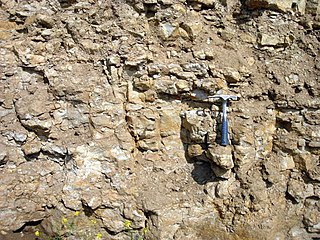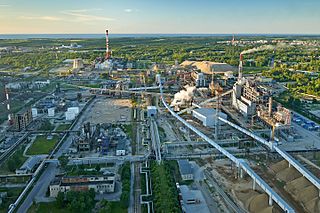Related Research Articles

Oil shale is an organic-rich fine-grained sedimentary rock containing kerogen from which liquid hydrocarbons can be produced. In addition to kerogen, general composition of oil shales constitutes inorganic substance and bitumens. Based on their deposition environment, oil shales are classified as marine, lacustrine and terrestrial oil shales. Oil shales differ from oil-bearing shales, shale deposits that contain petroleum that is sometimes produced from drilled wells. Examples of oil-bearing shales are the Bakken Formation, Pierre Shale, Niobrara Formation, and Eagle Ford Formation. Accordingly, shale oil produced from oil shale should not be confused with tight oil, which is called also frequently shale oil.
Unconventional oil is petroleum produced or extracted using techniques other than the conventional method. Industry and governments across the globe are investing in unconventional oil sources due to the increasing scarcity of conventional oil reserves. Unconventional oil and gas have already made a dent in international energy linkages by reducing US energy import dependency.
Shale oil is an unconventional oil produced from oil shale rock fragments by pyrolysis, hydrogenation, or thermal dissolution. These processes convert the organic matter within the rock (kerogen) into synthetic oil and gas. The resulting oil can be used immediately as a fuel or upgraded to meet refinery feedstock specifications by adding hydrogen and removing impurities such as sulfur and nitrogen. The refined products can be used for the same purposes as those derived from crude oil.

The Shell in situ conversion process is an in situ shale oil extraction technology to convert kerogen in oil shale to shale oil. It is developed by the Shell Oil Company.

Oil shale geology is a branch of geologic sciences which studies the formation and composition of oil shales–fine-grained sedimentary rocks containing significant amounts of kerogen, and belonging to the group of sapropel fuels. Oil shale formation takes place in a number of depositional settings and has considerable compositional variation. Oil shales can be classified by their composition or by their depositional environment. Much of the organic matter in oil shales is of algal origin, but may also include remains of vascular land plants. Three major type of organic matter (macerals) in oil shale are telalginite, lamalginite, and bituminite. Some oil shale deposits also contain metals which include vanadium, zinc, copper, and uranium.

The oil shale industry is an industry of mining and processing of oil shale—a fine-grained sedimentary rock, containing significant amounts of kerogen, from which liquid hydrocarbons can be manufactured. The industry has developed in Brazil, China, Estonia and to some extent in Germany and Russia. Several other countries are currently conducting research on their oil shale reserves and production methods to improve efficiency and recovery. Estonia accounted for about 70% of the world's oil shale production in a study published in 2005.

Shale oil extraction is an industrial process for unconventional oil production. This process converts kerogen in oil shale into shale oil by pyrolysis, hydrogenation, or thermal dissolution. The resultant shale oil is used as fuel oil or upgraded to meet refinery feedstock specifications by adding hydrogen and removing sulfur and nitrogen impurities.
Oil shale economics deals with the economic feasibility of oil shale extraction and processing. Although usually oil shale economics is understood as shale oil extraction economics, the wider approach evaluates usage of oil shale as whole, including for the oil-shale-fired power generation and production of by-products during retorting or shale oil upgrading processes.

The history of the oil shale industry started in ancient times. The modern industrial use of oil shale for oil extraction dates to the mid-19th century and started growing just before World War I because of the mass production of automobiles and trucks and the supposed shortage of gasoline for transportation needs. Between the World Wars oil shale projects were begun in several countries.
The American Shale Oil, LLC (AMSO), originally known as EGL Oil Shale, LLC, was a developer of in-situ shale oil extraction technology based in Rifle, Colorado. It was owned by Genie Energy and Total S.A. In May 2016, Genie Energy announced that the AMSO project was closing.
Red Leaf Resources, Inc, is an oil-shale company based in Salt Lake City, Utah, United States. It is a developer of the shale oil extraction technology EcoShale In-Capsule Process. The company is affiliated with Questerre Energy.
The TOSCO II process is an above ground retorting technology for shale oil extraction, which uses fine particles of oil shale that are heated in a rotating kiln. The particularity of this process is that it use hot ceramic balls for the heat transfer between the retort and a heater. The process was tested in a 40 tonnes per hour test facility near Parachute, Colorado.
Chevron CRUSH is an experimental in situ shale oil extraction technology to convert kerogen in oil shale to shale oil. The name stands for Chevron's Technology for the Recovery and Upgrading of Oil from Shale. It is developed jointly by Chevron Corporation and the Los Alamos National Laboratory.
The Paraho process is an above ground retorting technology for shale oil extraction. The name "Paraho" is delivered from the words "para homem", which means in Portuguese "for mankind".
The Lurgi–Ruhrgas process is an above-ground coal liquefaction and shale oil extraction technology. It is classified as a hot recycled solids technology.
The Nevada–Texas–Utah retort process was an above-ground shale oil extraction technology to produce shale oil, a type of synthetic crude oil. It heated oil shale in a sealed vessel (retort) causing its decomposition into shale oil, oil shale gas and spent residue. The process was developed in the 1920s and used for shale oil production in the United States and in Australia. The process was simple to operate; however, it was ceased from the operation because of a small capacity and labor extensiveness.
The Union process was an above ground shale oil extraction technology for production of shale oil, a type of synthetic crude oil. The process used a vertical retort where heating causes decomposition of oil shale into shale oil, oil shale gas and spent residue. The particularity of this process is that oil shale in the retort moves from the bottom upward to the top, countercurrent to the descending hot gases, by a mechanism known as a rock pump. The process technology was invented by the American oil company Unocal Corporation in late 1940s and was developed through several decades. The largest oil shale retort ever built was the Union B type retort.
Omnishale process is an in situ shale oil extraction technology to convert kerogen in oil shale to shale oil. This process is classified as an externally generated hot gas technology. The technology is developed by General Synfuels International, a subsidiary of Earth Search Sciences.

The energy sector of Ohio consists of thousands of companies and cities representing the oil, natural gas, coal, solar, wind energy, fuel cell, biofuel, geothermal, hydroelectric, and other related industries. Oil and natural gas accounts for $3.1 billion annually in sales while ethanol generates $750 million. Toledo is a national hub in solar cell manufacturing, and the state has significant production of fuel cells. In 2008, the state led the country in alternative energy manufacturing according to Site Selection Magazine, while the natural gas industry has experienced growth due to the expansion of shale gas.
The history of the oil shale industry in the United States goes back to the 1850s; it dates back farther as a major enterprise than the petroleum industry. But although the United States contains the world's largest known resource of oil shale, the US has not been a significant producer of shale oil since 1861. There were three major past attempts to establish an American oil shale industry: the 1850s; in the years during and after World War I; and in the 1970s and early 1980s. Each time, the oil shale industry failed because of competition from cheaper petroleum.
References
- 1 2 3 Michlewicz, Chris (2012-12-09). "Clean-tech oil shale company turning heads". Parker Chronicle. Archived from the original on 2012-12-12. Retrieved 2012-12-31.
- 1 2 3 "IEP snags production rights". Denver Business Journal. 2005-09-01. Retrieved 2008-08-20.
- 1 2 3 Fischer, Perry A. (August 2008). "Shale oil pilot projects proliferate". World Oil. Gulf Publishing Company. 229 (8). Retrieved 2009-02-12.
- ↑ Webb, Dennis (2009-01-24). "French firm expands oil research into Colorado". The Daily Sentinel. Retrieved 2009-02-12.
- 1 2 Secure Fuels from Domestic Resources: The Continuing Evolution of America's Oil Shale and Tar Sands Industries (PDF) (4th ed.). United States Department of Energy. 2010. pp. 52–53. Retrieved 2011-05-06.[ permanent dead link ] "Letter to the Senate Committee on Energy and Natural Resources" (PDF). Oil Shale Alliance Inc. 2006. Archived from the original (PDF) on 2014-03-12. Retrieved 2009-02-12.
- ↑ United States Congress. Senate. Committee on Energy and Natural Resources (2006). Oil Shale Provisions of EPACT: Hearing Before the Committee on Energy and Natural Resources, United States Senate, One Hundred Ninth Congress, Second Session, on the Implementation of the Oil Shale Provisions of the Energy Policy Act of 2005, Grand Junction, CO, June 1, 2006. United States Government Printing Office. p. 83.